Posted in Blog, Innovation by Jo North
From March 2020, with the outbreak of Covid-19 and the changes it has brought, how to pivot seems to have been one of the most prominent business themes in the media, after of course the financial and operational impact of the pandemic.
As a result of Covid-19, we have seen gin manufacturers pivot to making hand sanitiser, engineering firms to producing ventilators and medical equipment, and clothing companies to supporting with PPE (Personal Protective Equipment).
That said, pivoting is something that businesses have been doing since people started to trade goods and services with each other, and the core principles of successful pivoting remain constant.
How to Pivot Your Business
In this blog, I’m going to share the content of an innovation masterclass that I have been running with businesses to help them decide if and how they should pivot.
It’s important to balance the decisions you need to take right now to survive and thrive with the impact that these decisions will have longer term on your business.
You may be thinking about pivoting – which means making a change – large or small – to your business – if your current products and services aren’t performing well for you. I provide a pragmatic checklist and process for you to use if you are thinking about pivoting in your business.
By reading this, you’ll gain insights on how to:
- Make your business more relevant
- Implement business changes to generate more cash and profit
- Benefit from new opportunities quickly
How to Pivot – What We’ll Cover
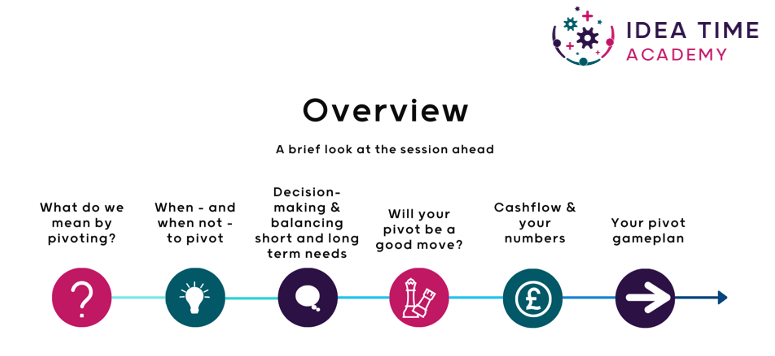
Together, we will cover:
- When – and when not – to pivot
- Decision-making and how to balance the short-term need with longer term vision
- Different types of pivot – customer, product, service, business model, portfolio addition
- How to find out if your pivot will be a good move – before you go for it
- Pivoting & cash flow – thinking through your costs and revenue forecasts
You can also download my pivot slide deck here for free, right now.
If you’d like any additional support and advice, please do get in touch with me via the contact us form below, and I’ll be delighted to help.
Definition of a Pivot in Business
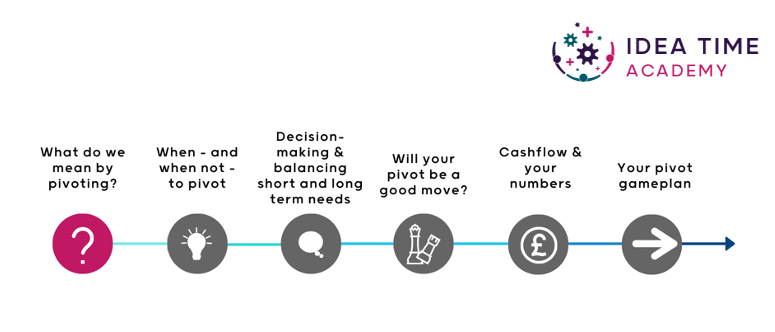
What do we mean by pivoting?
Eric Ries, in his book The Lean Startup, says that pivoting is…
“making a change in strategy, without a change in vision.”
Pivoting involves:
- Changing your products / services; or
- Changing your target customer; or
- Changing both, which will likely be a business model pivot.
Pivoting could also involve keeping your customers and products the same, but changing how you market them.
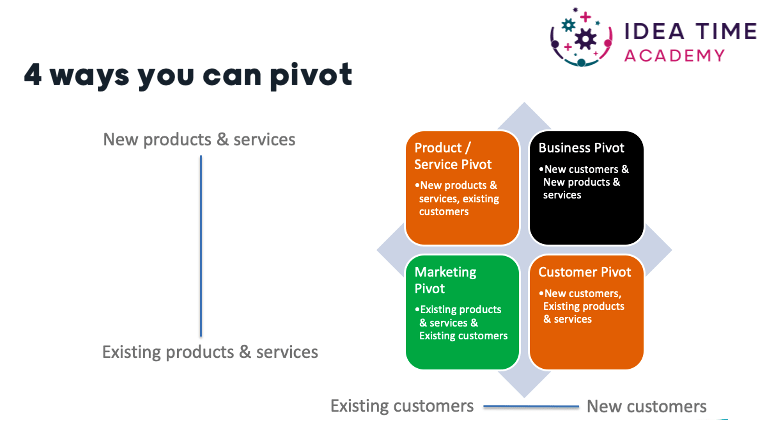
In general the more you change, the greater the risk. But there’s also often significant risk in choosing not to change!
When – and when not – to pivot
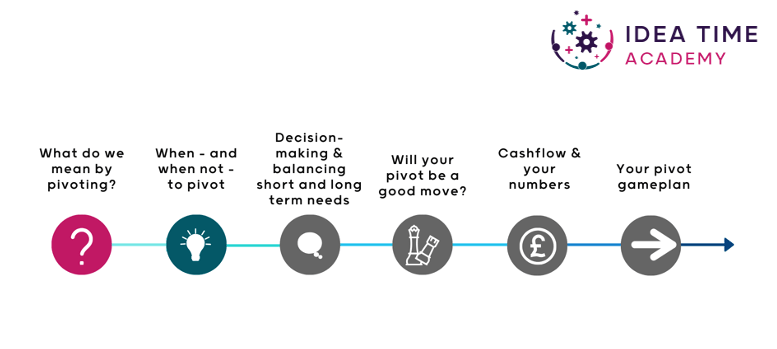
Consider pivoting when what you offer isn’t performing as well as you’d hoped or intended, when a new, potentially lucrative opportunity emerges or when you have a great idea that you think could work.
Staying on, or ahead of the curve
In reality, all businesses need to be making smaller pivots constantly to stay on or ahead of the curve. As the graphic below shows, because the environment – i.e. external factors, markets and customer needs change over time (the blue curve), our businesses need to always be adapting to those changes (the pink line in phase 1 of the graphic), preferably in a proactive way where possible.
When external circumstances change in a way we don’t expect, or when we take our eye off what is going on, strategic drift kicks in, and hits financial performance. Unless we take quick, targeted and appropriate action, over time the gap between what the business offers and what customers want continues to get bigger and bigger over time, and it becomes more challenging (and expensive) to make the big leap to where the business needs to be (phases 3 and 4 of the graphic below).
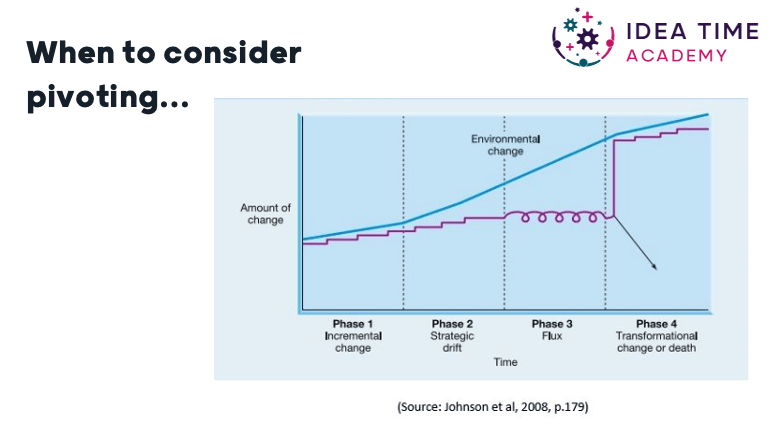
A personal pivot
Also, I’ve helped entrepreneurs and innovators to pivot for personal reasons, such as a significant life change or when they simply want a fresh challenges and change of direction.
Beware of the ’emotional’ pivot

When you’re considering a pivot, please do be mindful of what’s driving your decision and how you’re feeling at the time.
The Amygdala Hijack
Times when we are under massive pressure or experiencing high levels of stress are not the best for making decisions that could have a big impact on your business. As humans we are prone to the “amygdala hijack” when we feel threatened.
The amygdala is a primitive part of our brain that is there to protect us from danger. Under threat, it can feel that we need to make an immediate ‘fight or flight’ decision, or even feel like rabbits caught in the headlights.
The hormones we release in response generate a physical reaction, and it becomes harder for us to think clearly because zoom our focus right in onto the threat, and exclude wider information that we need to consider.
If possible, work through how you’re feeling and make decisions that could have longer-lasting impact on your business when you’re in a better place to do so.
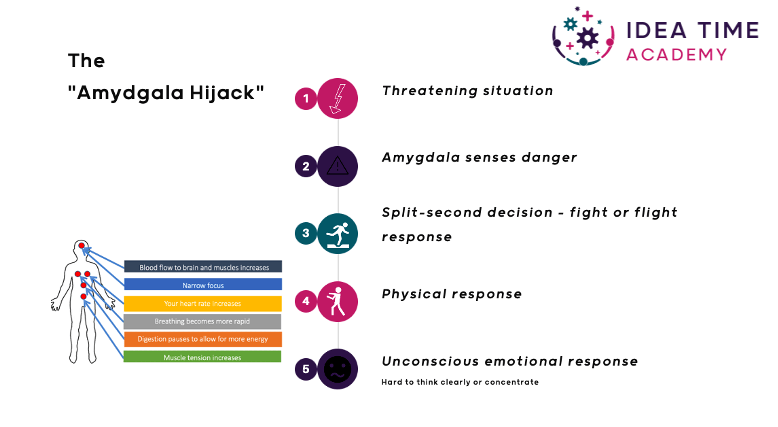
Decision-making strategies
I’ve written in detail about to to make sure that you make the best decisions for your business in my Guide to Making the Right Decisions for Your Business here.
Here are some more tips to help you with your pivoting decision.
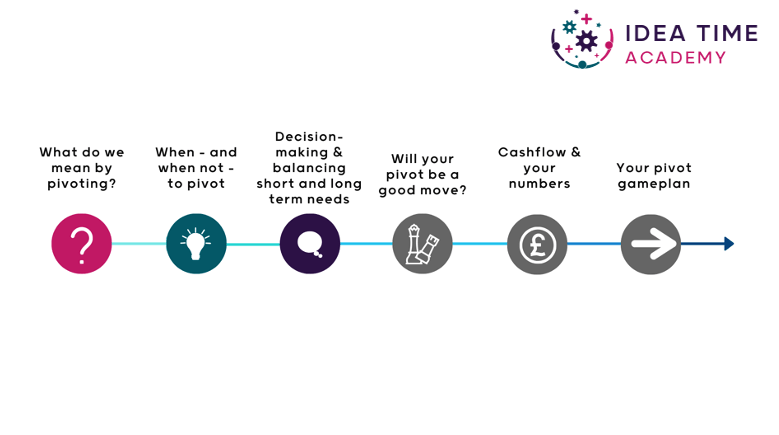
Balance your short-term and long-term needs and aspirations
Make sure that you balance your short term, immediate needs with your long term goals. How to pivot successfully means either using your pivot to achieve your vision more effectively, or as a minimum making sure that your pivot doesn’t get in the way of your overall aspirations.
If you need to do something drastic to get you through an immediate challenge or crisis, then do your best to ensure it’s either reversible once the issues have passed or have the minimum negative impact on your overarching vision.

How to pivot checklist for decision-making
Use this pivoting checklist to inform your decision. Take account of:
- The current business climate, especially in your sector and location.
- Current trends and forecast changes to those trends.
- The impact of and potential leverage from your brand.
- How much working capital you have available, along with the project timelines and financial investment needed.
- The stability of your business in its current and projected trading environment.
- The competition that you’ll face.
- The regulations and legal requirements that you will need to adhere to.
- The impact that your pivot might have on other aspects of your business.
- How you might evolve your pivot into a longer term strategy.
Decisions and emotions
Remember that even when we think we are being logical and analytical, research shows that the vast majority of our decisions are based on emotions rather than evidence. We take decisions to help us feel how we want to feel! That could be safe, comfortable, confident, excited, challenged…. and more!
Combine data AND intuition
Combining data and evidence with your intuition really does help to balance the emotional aspects of decision-making.
Work out what questions you have about whether or not you should do ahead with your pivot, and how best to make your pivot happen. Define what success means to you. Then go and find the data – which is simply information and evidence, and comes in many forms – to answer as many of your questions as possible and give you insight.
You won’t find data to answer all your questions, and some of them can’t be answered until you actually go for it. But you can have more confidence in your pivoting decision because you’ve done all reasonable due diligence.
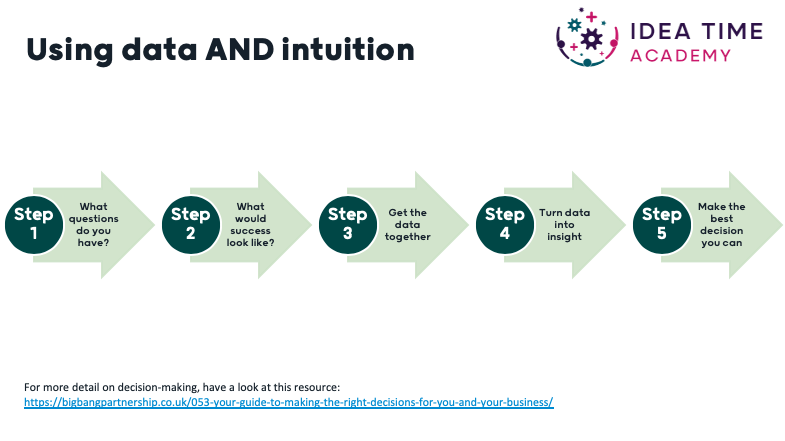
Will your pivot be a good move?
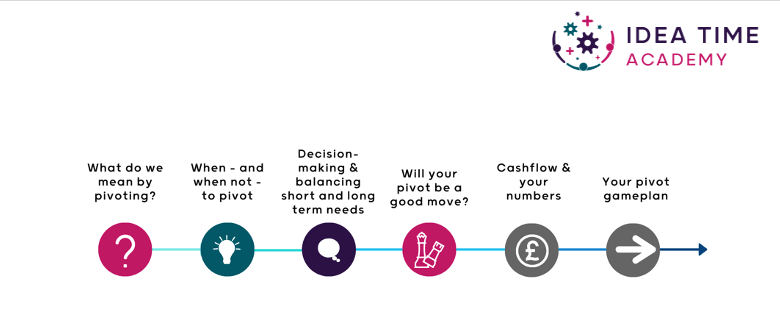
Create an MVP
To test whether your pivot will be a good move or not, create an MVP, which stands for Minimum Viable Product.
This is simply a version of your new product or service that you allows you to get early customer feedback, before you go all in and spend a lot of time and money on your pivot innovation.
Here are some activities that you can use to create your MVP.
Once you have your MVP, test it as inexpensively as possible. learn, make changes and then test again. Test fast, learn fast, develop fast.
Consider where your customer is at
Businesses exist, survive and thrive because in some way they solve a problem for their customers.
As you can see in the graphic below which summarises classic and enduring work by Gene Schwarz, when customers have a problem, they have varying levels of awareness of that problem and of your ability to help them solve it with your products or services.
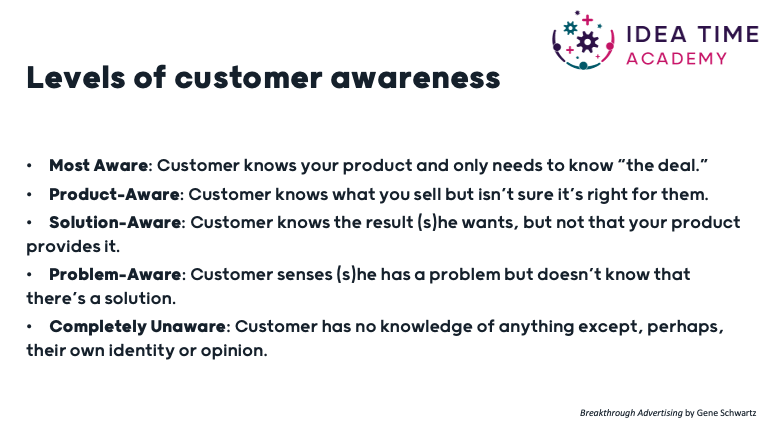
Arguably, the more aware your customers are on Schwartz’s definitions, the greater the probability that your pivot will succeed on the market. However, as your pivot is new, customers won’t be aware that you can help them.
The skill in smart pivoting is to target at least problem-aware and preferably solution-aware customers with you marketing and communications to get the best returns fastest. When you’re successfully doing that, you’ll move customers up the levels as they become product-aware and ultimately most aware and buy.
Assumption testing
It’s definitely worth spending a bit of time to test the assumptions that you’re making about your pivot. For example, you may have an assumption that the market is massive, or that customers need your new product or service so much that you’ll be struggling to cope with demand.
Use the table below to list all the assumptions that you’re making – you’ll be surprised at just how many there are!
For each assumption, decide how you will test whether it’s an accurate assumption or not, what actions you need to take to test it, any investment needed and when you will complete your test. Then go ahead and crack on with your assumption testing.
No innovation is guaranteed to succeed, but you will definitely de-risk your pivot by doing this very simple and powerful activity.
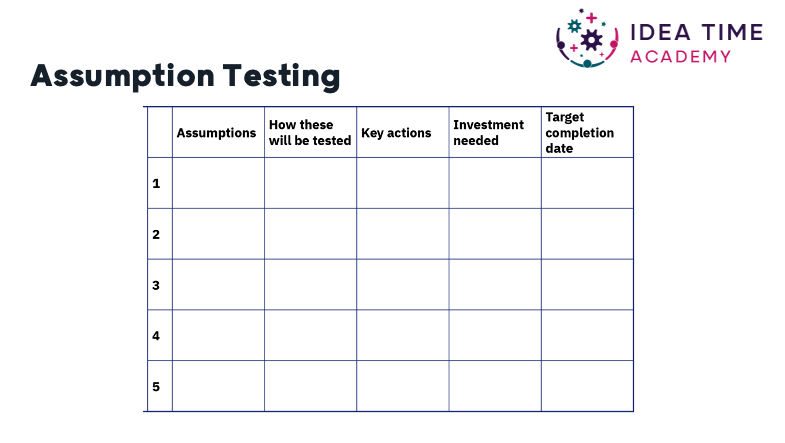
Cashflow and your numbers
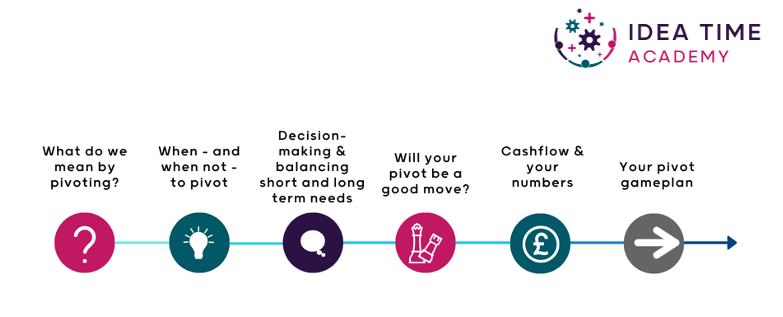
Please do a detailed and regular assessment of the impact of your pivot on your business cashflow. I can’t emphasise how important it is that you are always on top of this, and project your cashflow forecast into the months ahead.
Some free cashflow planning resources for you to download
My great friend and associate Mahmood Reza, The Numbers Rockstar, has some fantastic expertise and free resources available to you to help you with this.
Getting your cash flow in order is key to a successful business, whether you’re pivoting or not.
To help you know your numbers, Mahmood has produced a handy guide to cashflow, and a cash planning model spreadsheet. With these resources you’ll be able to learn how cash forecasting puts you in the driving seat of your business and understand what you need to do to get to where you want to be. Download them here.
If you want to grow you confidence with your business numbers, also have a listen in to Mahmood’s I Hate Numbers podcast – you’re in for a treat!
The J-curve or innovation hockey stick
It’s obvious that while we are working on innovations and getting our pivot ready to launch there is a period in which we are spending on development but not generating any revenue and consequently profit. This is known as the J-curve or hockey stick effect, as shown in the graphic below.
Pivots often take longer to execute and cost more than predicted at the outset of the project. Do your best to minimise the width of the bottom of the ‘J’ – the time the project takes to launch – and the depth of the curve, i.e. the costs. You’ll avoid unnecessary costs and keep your launch expenses to a minimum and potential profits higher.
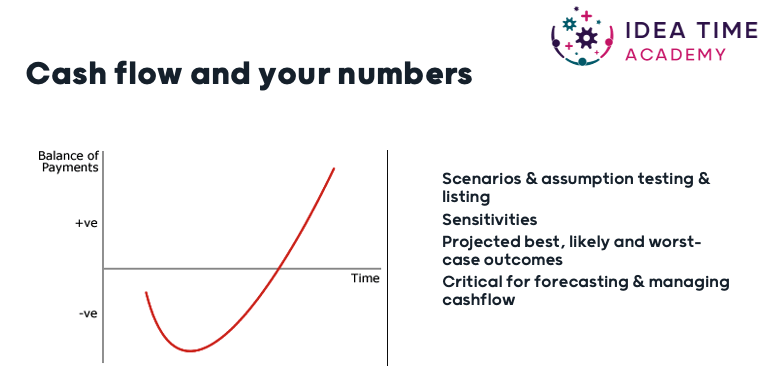
Forecasting revenue
Forecasting how well your product will sell, and how quickly – i.e. your revenue numbers – can be challenging because your pivot by definition will be taking you into new arenas.
My recommendation is that you create a realistic best, worst and most likely case scenario. Create contingency in case the worst scenario happens, and track your sales and margin performance super-closely always – and especially in the early stages – to quickly jump on anything that you may need to tweak or change.
Your how to pivot gameplan
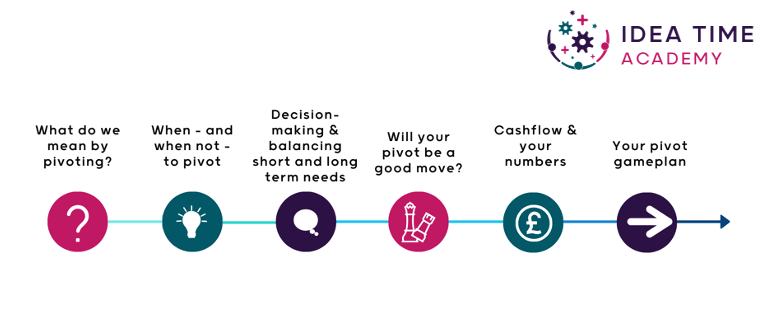
Now it’s time to pull all these threads together in your how to pivot gameplan.
- Develop a clear proposition
- Assess the fit with your capability, expertise and business
- Test customer demand via a low fidelity prototype or MVP
- Validate your idea, and test your assumptions
- Refine your investment case and impact on cashflow
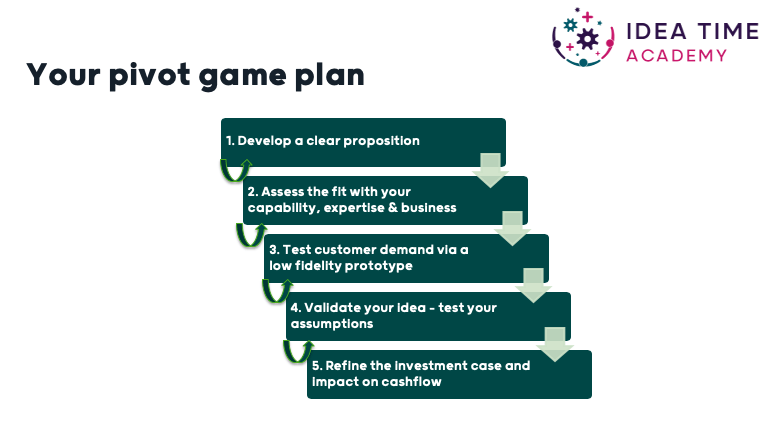
And finally…
You’re all set and ready to go!
If you’d like any support with your pivot, me or my colleague Mahmood are here to help. Get in touch using our contact us form here, and we will be straight back to you.

